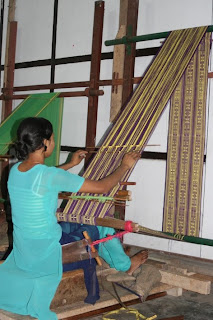 Looking at the retreating Gangotri glacier from a sadhu's shrine to Shiva. The peaks at the rear are named after the Hindu Trinity.
Looking at the retreating Gangotri glacier from a sadhu's shrine to Shiva. The peaks at the rear are named after the Hindu Trinity.After spending some time acclimatising to the altitude and the change in temperature we were ready to start walking. Gaumukh is 18kms along a well defined trail and another 1000 metres higher: our destination for the day is a small ashram 14kms along at Bhojbasa. Bhoj means birch, and the small vale was once covered with the trees which are long gone, except where humans can't access them across the river. Anyway, after a short distance from Gangotri we reached the gate of the national park armed with our permits. The fee for 2 days for Indians is Rs50, for "foreigners" is Rs350. The word Indian in this case, as is the case at all tourist areas like the Taj Mahal or the Mysore palace, does not actually mean a native of India at all. For example, the NZ cricketer Jeetan Patel would not be charged as a foreigner; a 5th generation Fijian of Indian racial background would not be charged as a foreigner; likewise a South African or my Sri Lankan Tamil friends from Melbourne for that matter. Rascism in India oozes from the entrenched discrimination of the caste system like pus from a wound; effortlessly and easily, and they can't see it. A certain incident on the Australian cricket field comes to mind. If the boot was on the other foot, they would be complaining the loudest.
Supposedly, this rule is because the "foreigners" have the most money. Ha! The foreigners who can get up there are the intrepid budget backpackers who stay in the Rs200 hotels - the Rs3000 (and much more) hotels are invariably occupied by the nouvea riche Indians - and there are plenty of them. There is a bigger cashed up middle class here than the entire population of the US. Just look at the $us50 million the IPL cricket spends. So on we walked along a stunningly beautiful trail, past small glaciers, through varying forest cover as the sun rose over the high peaks. Around each corner there was yet another massive snow peak looming.
There used to be five small temporary "dhabas" - a place to get a cup of tea or fresh paratha (an unleavened bread, folded and layered with butter like a croissant, then fried and served with pickle) or other snacks. In fact I had been relying on one to have some breakfast, but they have been banned this year. Now there are skeletal remains, detritus and rubbish lying around. They had bins by them, but they were no longer emptied except by the stiff Himalayan winds which spread the rubbish far and wide. An article about the new permit system in the newspaper after we returned said that "a slew of measures were put in place to limit garbage"; what a joke. The opposite is true, and now people carry their own food in wrapping and containers that they chuck anywhere and everywhere. It needs to be understood in the context that India is THE most garbage-strewn country in the world: Indians drop litter anywhere and do so without a second thought. Trains supply meals in foil dishes, plastic etc, and provide no bins so it all goes out the window making Indian rail tracks the longest garbage dumps in the world. There are 1.2 billion people dropping rubbish more than once daily...everywhere.
So we arrived up at Bhojbasa and the little ashram up there provided a simple dal and rice lunch (and very good evening meal). We were followed up the trail by a group of about 100 Tamils with their old guru. Some of them reached Bhojbasa, a few went on to Gaumukh 4kms further, but most didn't quite make it and turned back earlier. They brought their own lunches with them - all identical in foil containers with lids, a foil coated paperplate and pink plastic bags. When they finished, they just hoicked their rubbish over the ashram wall. I asked the well-educated Tamil next to me what he intended to do with his foil and plastic. He was just dumbfounded by such a question - it was literally something he had never given a thought to, and asked me why I asked. I told him that in most countries, people take all their rubbish out of the national parks and leave only footprints. He just couldn't grasp it. It rained most of the afternoon, and about 150m above us was fresh snow on the hillsides. Next day we walked on up to the big Gangotri glacier, from which springs the fully formed river Ganga as a raging torrent. We saw where the other Tamils had lunch in this otherwise pristine place. The scenery is utterly breathtaking, the higher you walk, the higher the mountains around the corner become. We heard the cry of what we thought was an eagle, Cathy looked up and spotted a mammal slinking along a ridge with fluid movements. We saw a flock of Himalayan "blue sheep" high above, and on the trail noticed some interesting scats; a couple of large ones full of fur, suggesting a leopard or wolf; another I thought may have been a bear. We also saw a small tailless rat - a vole I imagine. After a second comfortable night up there it was an easy stroll back down to Gangotri.
 Andrew's house in Chiang Mai.
Andrew's house in Chiang Mai.






























